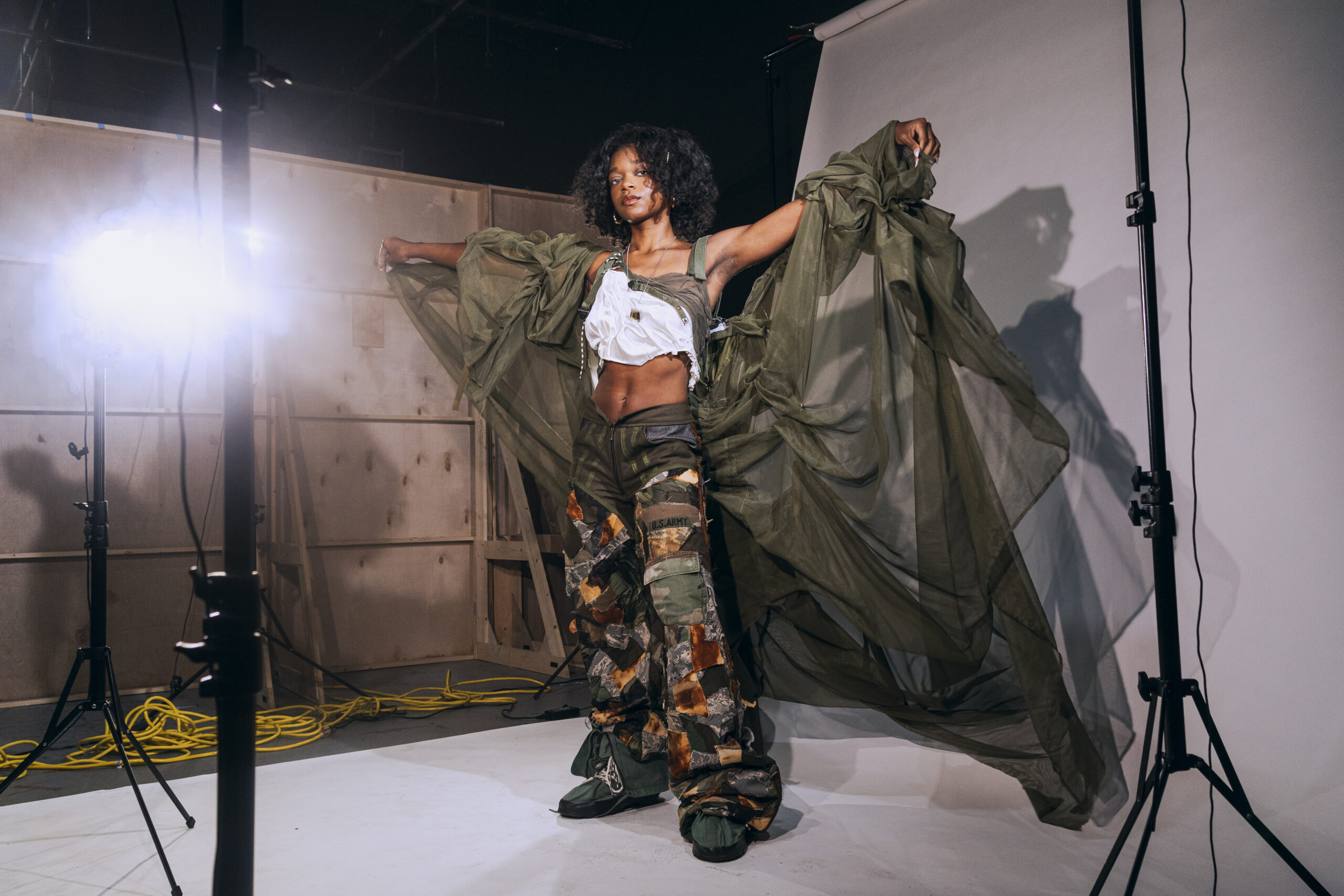Fashion is the way society sees you: Who you are, what you value, and what inspires you in the quickest of moments. This surface-level glance shows the work but not the person.
We don’t see the hours of emphasis that go into creating something as simple as a white button-down (Logan Fluharty says it takes him about 20 hours), we don’t feel what it’s like to grow up as a military kid like Jailynn Tabanico, and we certainly aren’t caught up on the Freudian idea of the Ego like Jia Gore. The clothes don’t always make the person, but someone definitely makes the clothes.
In honor of the editorial, another process often overlooked by the beauty of the final image, we gathered 10 of this year’s fashion design seniors to peek into their process. So now’s your turn to explore. Who are they, what do they value, and what inspires them?
Rosie Abuin Maracaibo, Venezuela
In her senior collection, “Threads of Duality”, Rosie Abuin upcycles the legacy of her family’s tailoring store in her native city of Maracaibo, Venezuela. In the 1950s, her Grandfather left Spain to bring classic tailored menswear to Venezuela. He started as a retail associate before deciding to start his own tailoring business. This industrious spirit was undoubtedly passed down to Rosie. Her designs are innovative, sharp, and cool. In her collection, she synthesizes the tradition of classic tailoring with cutting-edge, bold designs of current streetwear.
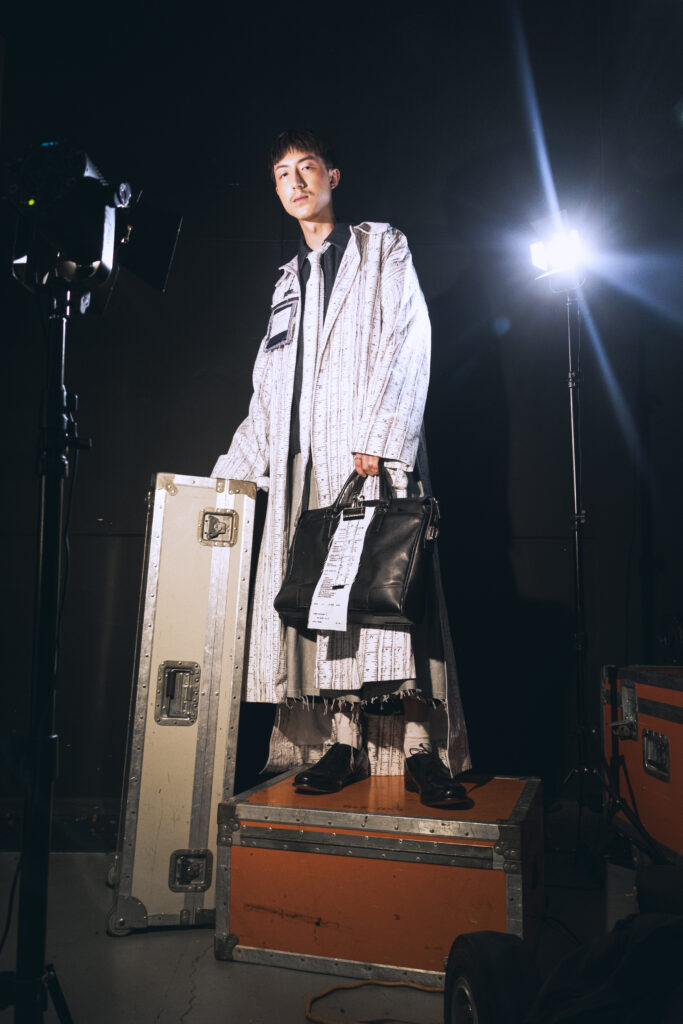
Abuin stepped a bit out of her comfort zone for her senior collection, but this experimental endeavor paid off massively. She explained to me that she had not previously designed menswear: “I feel like it was making my collection menswear. I specifically designed womenswear before, and Andrew, my professor said ‘it doesn’t make sense that you’re making a womenswear collection with this concept, because it’s a classic men’s store.’ And so I just have to adapt it to like, wear-wear, but it has a more menswear sensibility.”
One of her most dazzling designs is a handbag with a clothes hanger handle, “almost as if”, she says, “you’re still shopping”. Her ability to find inspiration in the most unlikely scenarios is even more impressive. The idea for this handbag came from her internship experience. “This is where it came from. This is me at the office over the summer, and they were making me carry all these garments to the basement, because that’s what you do in an internship, right? And I was wearing the hanger like that, and I told my boss ‘hey can you take a picture of me?’”
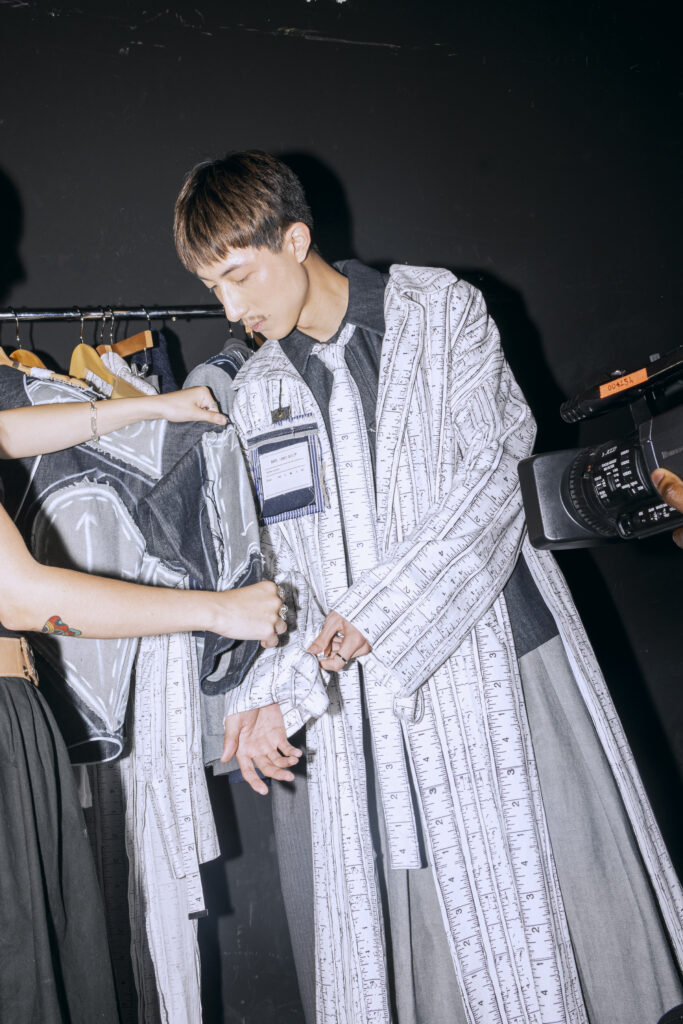
She has a genius ability to make successful design features from these anecdotes. Another clever example is the fit of some pieces. Abuin was inspired by stories of her father as an eight-year-old working in the shop. Even at such a young age, he was regarded around town for his talent in picking garments for clients. She develops this idea into an oversized aesthetic: her garments look as if the models wearing them still need to grow into the pieces. She also found inspiration in her measuring tape, which she developed into a stunning print that features in her collection.
The result of these ideas is a collection that is chic yet slightly ironic. To an eye trained in fashion design the references are humorous and comforting. Her collection is personal and slightly nostalgic, but it does not look sentimental or stuffy. Her silhouettes stay fresh and fashion-forward. The result is a crisp and slouchy ode to her family’s fashionable past. Abuin clearly understands the importance of being a multifaceted designer and growing her aesthetic vocabulary. She said to me: “When you challenge yourself with new things it sparks better creative choices. I feel like I was so stuck in making this womenswear with a very frilly meets edgy sort of aesthetic. But this is something so different.”
Logan Fluharty St. Louis, MO
How do you define noir? A single lamp illuminating the street, the curl of smoke from a cigarette in a hazy lounge, or maybe even the click of a typewriter placed in an office with a frosted glass door. Sound intriguing? Well, menswear designer Logan Fluharty is mesmerized as well. Films like “Double Indemnity” and “Se7en” pushed Fluharty to explore the world of film noir and confront all aspects of the genre.
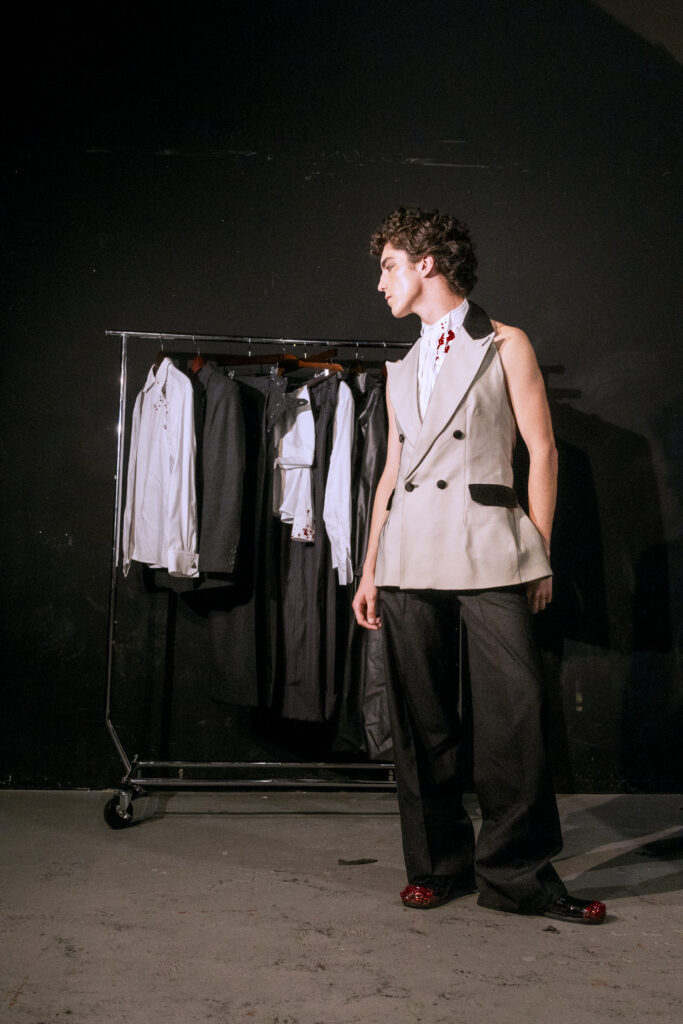
“Think of the nihilism and then the grittiness within those movies. They all kind of portray these corrupted and nihilistic men dressed in these sharp suits chasing around or (being) controlled by the femme fatale…I wanted to make something that’s kind of gritty and turn it into a statement of glamor or make it a little bit more elegant.” Fluharty explains as he walks me through the intricate yet intentional detailing on each look. Whether it’s the bedazzled blood stains, hidden charms, or disappearing lapels, everything encapsulates “the ghost of the femme fatale.”

However, tailoring is as much of an art as film, and that’s not a skill that comes easily. Fluharty’s collection, entitled “The City Wears You”, is all about impeccable sharp suiting and clean tailoring, making it a standout for anyone who sees it. But, if I told you he had only learned to make a suit at the start of his senior year, let alone a fully detailed trench coat out of thermoplastic polyurethane, you would think I was lying, but I’m not. “What I learned this year is insane. I didn’t know how to make a suit before.” He recounts as we discuss all the new skills he’s easily picked up in the past few months, “since it’s (the tpu trench coat) not a fabric, it was really interesting to learn how to sew it. It’s just completely different than everything we were taught. I had to figure out a new way.”
Fluharty’s dedication to his craft easily outweighs the seemingly impossible. Not finding fabric online? Simple, he’ll just fly to New York, empty suitcase in tow, and fill a checked bag with the finest pinstripes, cotton, and buttons Mood and B&J Fabrics have to offer. Fluharty’s collection encapsulates everything modern menswear tends to be missing. It’s balanced, chic, unique, and versatile, but most importantly, it’s wonderfully constructed by a passionate and skilled designer.
Jailynn Tabanico Savannah, GA
Jailynn Tabanico, a Savannah native, found inspiration for her senior collection, “Utilitarian Feminine”, close to home. She was profoundly inspired by her father’s experience in the military. It shaped the stories he told and the objects around home when she was growing up. She takes this idea of military kitsch and refreshes it by incorporating textile manipulation and upcycling into her design decisions.
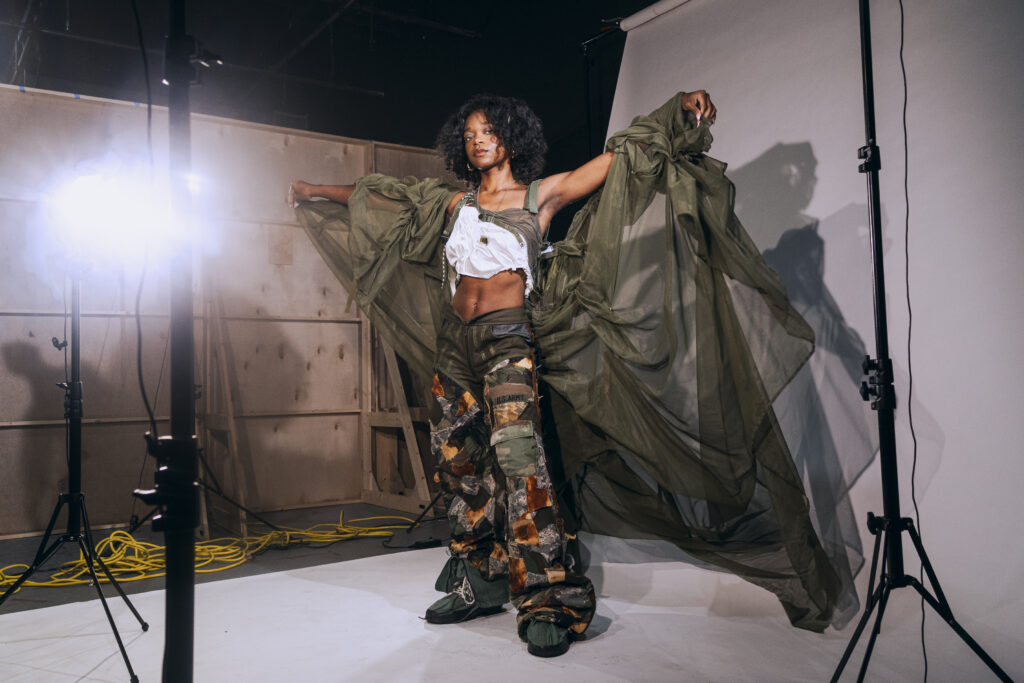
Tabanico also explored hand-dyeing and played with adding hardware to her garments, “so this was actually a tan suede that I dyed orange, and then for this I took these leathers and put them together then I added a lot of hardware. So that’s what you’re gonna see a lot in my collection. I love a lot of hardware, new and vintage from military wear.” This process is deceivingly simple. Tabanico eclipses textile modification; she has the ability to completely transform them. She maintains this elevation through her color story by going beyond traditional military colors in her collection and mixing in vibrant oranges, soft creams, and deep blues to add interest.
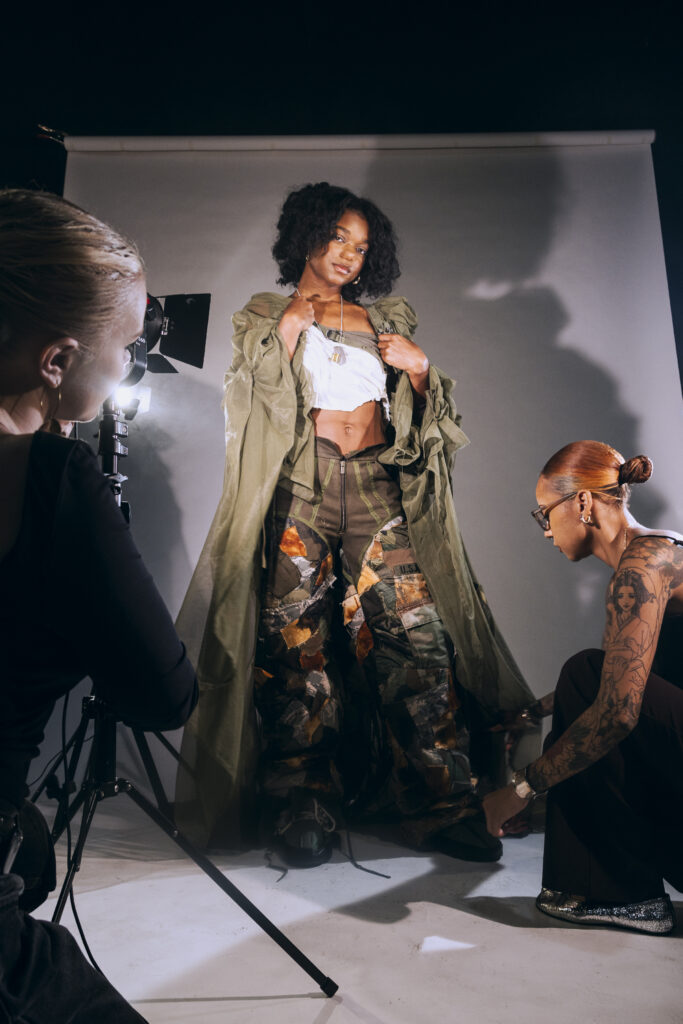
She also has a great ability to manipulate the viewer’s attention. “I really started taking inspiration from old military garments, and also silhouettes of parachutes and planes, then I looked for small elements I liked, and then combined all of them together. I wanted to keep a lot of the silhouettes pretty simple, but still voluminous, because I do a lot of textile manipulations, a lot of dyeing. I want to let that speak for itself.” This eye was developed in part by the accessory classes she took here at SCAD, allowing her to work with materials like leather and get such a polished and professional result.
While her concept may seem like it leaves little room for femininity, Tabanico still manages to create space for feminine beauty within her collection. She included both menswear and womenswear in her lineup but sought to design garments that made the women wearing them feel good about themselves. Tabanico said herself that she was going for “sexy, but still very powerful and very utilitarian.” And the result is nothing short of empowering. The power doesn’t just come from the militaristic aesthetic, but from strength and power that the wearer gains from putting on the garment. The strength that comes from feeling sexy and feeling yourself. It isn’t sexiness from a lack of clothes, it’s sexiness from wearing the right clothes. Overall, “Utilitarian Feminine” aims to elevate the military concept, “that’s what I really took into consideration, which is just elevate. So I did elevate material, elevate silhouettes, elevate everything.”
Hollis Maxon Berea, KY
In “Heritage and Hands”, Hollis Maxon of Berea, Kentucky, patches together a pastoral fantasy of craft, community, progress, and Appalachian charm. Their collection is an ode to his upbringing and family ties in the folk arts and crafts capital of their home state.
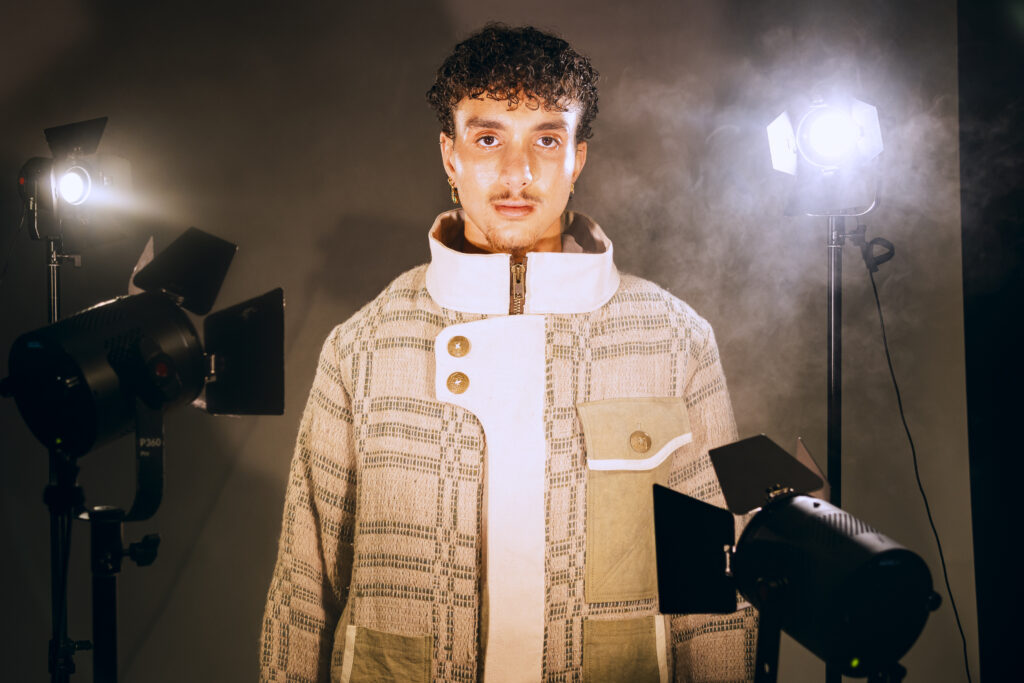
Maxon, clad in an ultra-chic double denim moment, offers me a beautifully apt statement of purpose: “The collection is about the storytelling history of the crafts in the region. The kind of the power that crafts themselves have to build community, and I am also trying, more broadly, to start a conversation about how Appalachia is seen and spoken about. A lot of times, I find that it’s painted with a really broad brush that discredits the decades of incredibly hard work by artisans in places like rural Appalachia.”
But their collection does more than depict broom makers, quilters, carpenters, weavers, and glass blowers; it proclaims the often overlooked tradition of progress and community organization in his homeland. “The reason we have labor movements and unions in the US is because of the Blair Mountain coal labor battle, which happened in Appalachia. It’s been the hot bed of so much really important organizing. So I am using craft to tell a history and a story of that organization while also making functional garments.”
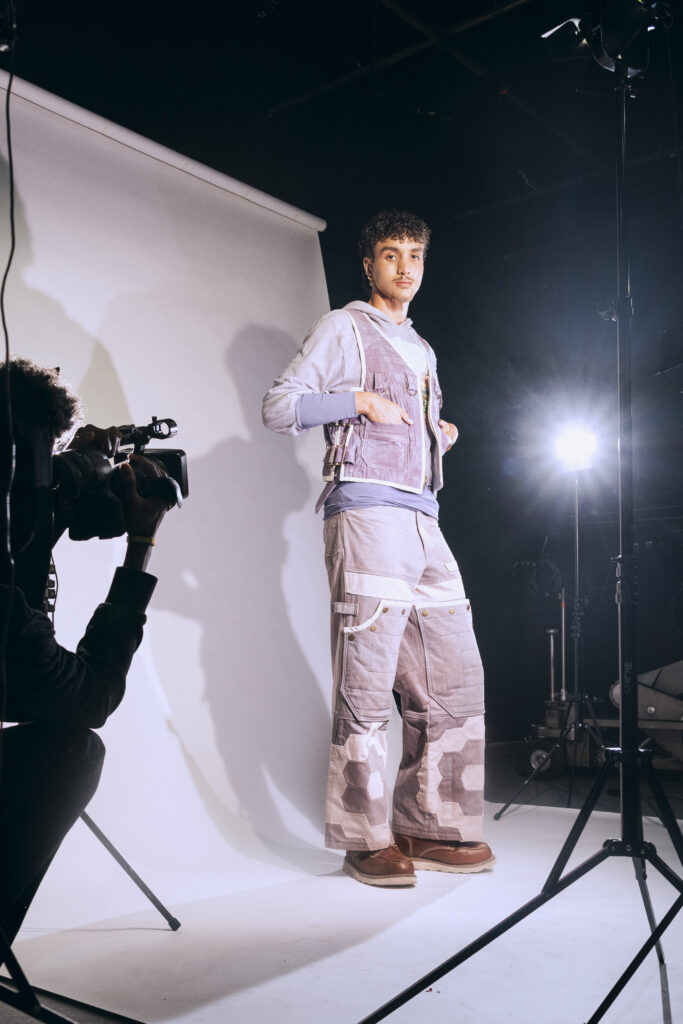
This story is especially personal to Maxon. Both of their parents were community organizers, but they stress to me that this is a story about themself, too, so the garments are careful not to be costumes of artisans but instead a love letter to the flourishing craft culture of the place he grew up. They play into this idea of honoring the arts and crafts in more than just concept. They worked with Greta Vanstrum, a fibers student here at SCAD, to employ a more traditional method of dyeing his garments, using plants like pomegranates, madder, and sage. Collaboration was a key part of their collection. They worked with a blacksmith in rural Kentucky to fabricate hand-forged brass side tabs, and they also hand-forged and chiseled all of the brass buttons in the collection with quilt designs on them.
At its heart, the collection supports the foundational quality of craftsmanship. It proves that a healthy and thriving crafting community is healing and unifying to an area’s culture. Berea, KY, is a very small town, and it’s centered around craft and the people who do them. They say, “It’s the ways in which craft can then become cornerstones for a really, really good community that then allows us to have those other conversations about organizing and all these great things.” Maxon’s collection is nothing short of hopeful, tender, and charming: A heartfelt reflection of their Appalachian hometown.
Chloe Corso Louisville, KY
Chloe Corso is designing for our current Industrial Revolution. In her collection, “Man in the Machine”, she comments on humankind’s current relationship with work environments and technology. She synthesizes inspirations from the Industrial Revolution and the modern digital era through her careful selection of materials: “I’m using more traditional workwear fabrics, like denim, twill, chambray, and wool melton fabric. I had a fiber student that I collaborated with. She, Amanda Zvolensky, quilted the chambray into a mechanical inspired design. Then I have a canvas painter’s cloth that was actually my dad’s, so I repurposed it. In some pieces I embellished the painter’s cloth. I felt that that paint splatter with the Swarovski crystals visually represents that idea of the fusing of something more traditionally technological with something more modern.” In her opinion, the piece that does this most successfully is a jacket she designed inspired by a gear mechanism. She relies on visual research to develop her collection, using a sketchbook collaging process to develop silhouettes and design ideation.
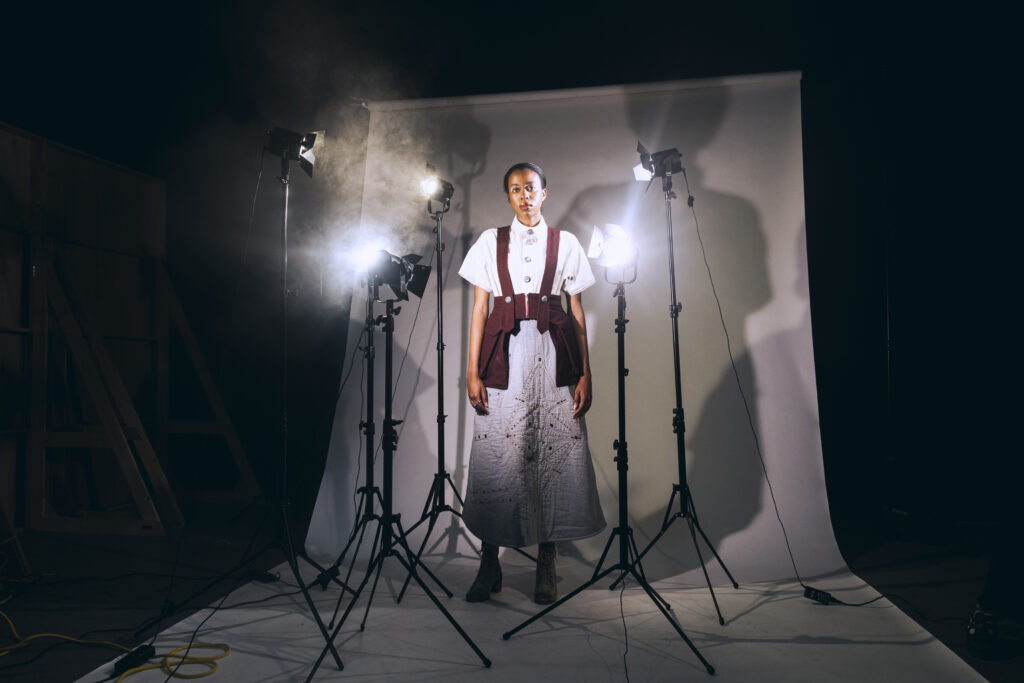
After our discussion about her tech-driven concept, I wanted to know Chloe’s opinions on the future of technology. Despite the heavy and usually overwhelming nature of the topic, she was able to keep the mood light, humorous, and pleasant. This is her theory of our potential technological future: “Actually, I have this theory in the back of my head that something’s gonna happen and we’re going to lose all digital technology. Everything is on the power grid, and I have a feeling the power is gonna blow and we’re gonna go back to churning butter. We’re gonna be hunting and gathering.” She explains, at the heart of her collection, what she really is exploring is the question of whether humans and technology coexist…or if we’re losing our human essence and merging with machines.
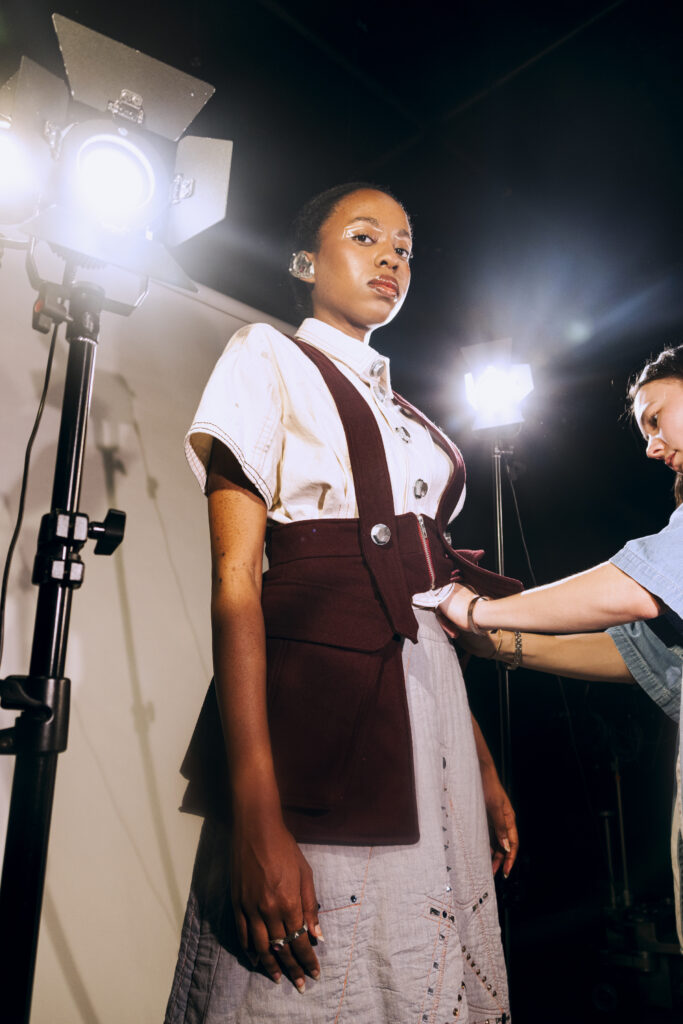
When we conclude our slightly unserious conversation about a technological collapse, we get to more pressing matters: What is the actual experience of being a fashion design senior like? What was the most difficult aspect of creating this body of work? Chloe gives her very eloquent take, inspiring for me to hear as a fashion design sophomore. “Just struggling against overthinking and learning to trust yourself is so hard, especially within anything creative. It’s all so subjective. Growing up, my brain was always right and wrong, very black and white, and then, once I got to art school, it was like, oh, that’s actually not the case at all. You have to understand that you can do whatever you want, and there’s no right and wrong. Learning to trust myself and be confident in my design decisions was something that was really difficult. Not to mention just the actual physical labor of it all, right?”
At the end of the day, Chloe Corso makes a beautiful argument about the nature of humanity. Even if we are in the midst of a new technological era or Industrial Revolution, it is of the utmost importance to stay human. We are not machines; we are people, and we need to remain separate.
Ethan Pope Los Angeles, CA
In his menswear collection “Stardust”, Ethan Pope nods to the enduring impact of the Harlem Renaissance, with every piece honoring the rich legacy of culture and black elegance. Aiming to open the door to the history of Harlem and its impact on black art, he dives into the movements and artistic happenings that left long-lasting effects into today. Listening to Pope speak so calmly and eloquently, I was captivated by his concept and references. It feels extremely relevant to many conversations surrounding fashion right now.
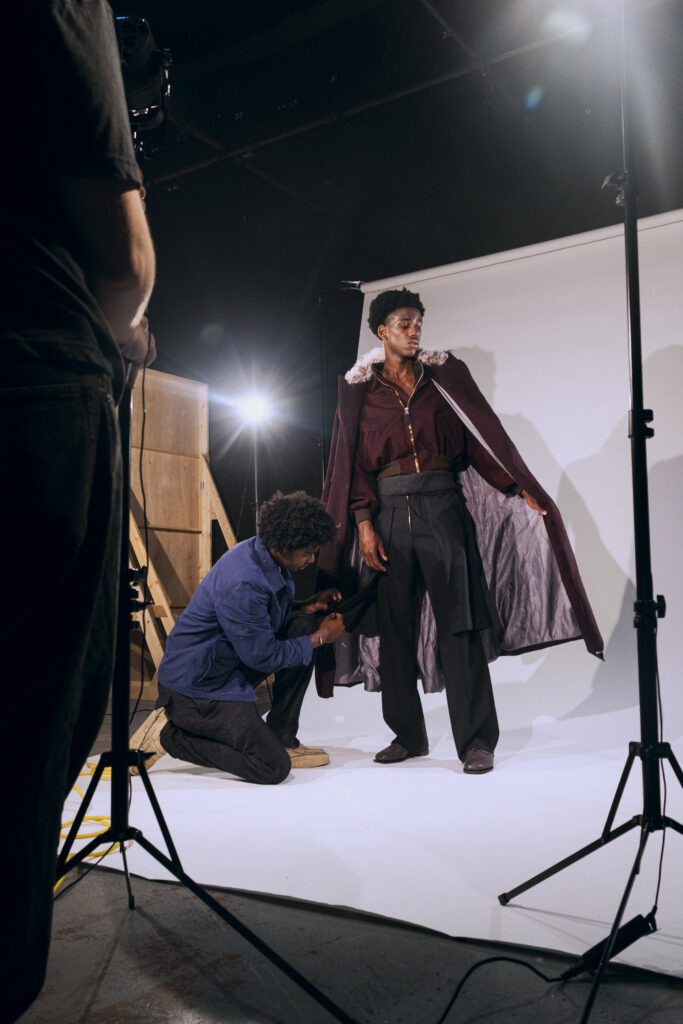
We examine his favorite look together. “This is a morning coat, which typically would be lined, and I kind of embraced the quality of the leather. I left it raw-edged and there’s no lining so the leather is already really stiff. It’s kind of an interesting jacket because you would think of it as something you wear kind of like a trench coat or something that you’re covering everything and super lined and heavy, but I kind of like it being a lighter take on it, and the fact that you could maybe wear and layer it with other things and play with what’s under it.” Creating a juxtaposition through his fabric choices and their elegant associations, bringing “a cooler twist” to the movement. He offers me specifics on what he took away from his extensive research: “A lot of inspiration from all the archetypes of men and women working in Harlem during this renaissance and this kind of explosion of culture that took place in Harlem. It became sort of a mecca for black people, for style, but also just for scholars, writers, dancers, anyone who felt dignified and wanted to take part in this new kind of movement that was going on in the 20s.”

But don’t let his deep exploration and passion for the topic make you think this is an exclusively historical collection. Pope brings in unexpected elements to modernize and acknowledge the era of black creativeness that is often overlooked and not recognized while also making it his own. Immerse yourself in the wealth of knowledge that is Ethan Pope through his inherently beautiful collection and its connection to the groundbreaking movement of the Harlem Renaissance.
Jia Gore Fleetwood, PA
A few weekends ago, I met Jia Gore, the most joyous girl I’ve had the pleasure of interviewing, and experiencing her favorable attitude on an early Sunday morning shoot brightens me up once again. Her collection, “Wake Up From the Big Snooze”, is rooted in Freud’s theory of the id, the ego, and the superego, which she further transforms into an idea of self-awakening. Explaining her collection to someone unfamiliar with this theory, myself, proves easy, “it kind of refers to the ego as the big snooze, because it’s something you need to awaken from, something you need to kind of break out of, in order to keep going within your best self. The collection is combining the psychology side with this, almost spiritual, personal growth side.”
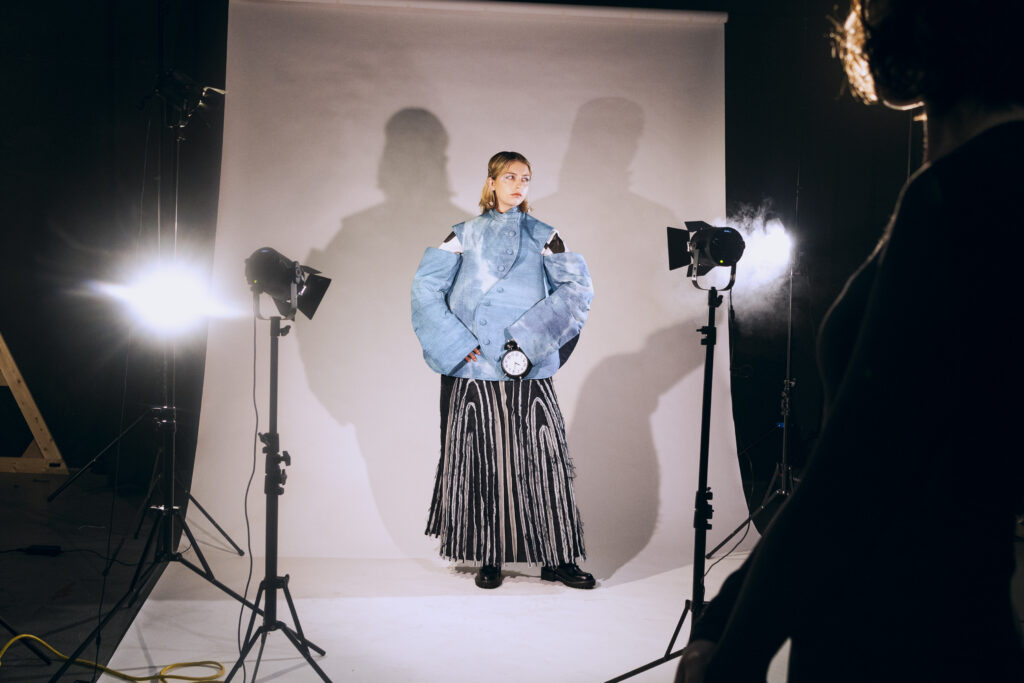
Gore’s collection is both menswear and womenswear, and it immediately catches my eye with its cohesiveness. The pieces are denim-based, allowing her a lot of freedom when pairing prints. However, there is a clear blue-based color scheme that was inspired by the CT scan of a brain. We pick up her “big vest top” to take a look; it features an intricate cyanotype print of many faces Gore calls “the identity print”. She tells me how much fun she had when creating the entire collection and that the print was actually a relaxing summer activity; she makes everything sound like a breeze.
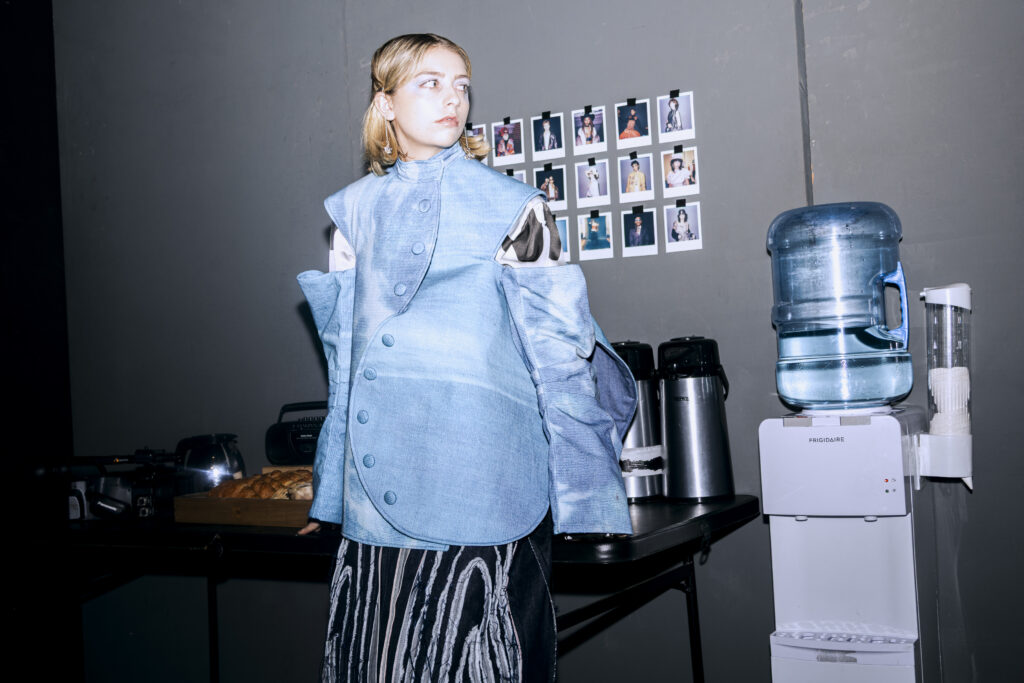
“You take a picture and you make it a negative, and then when you go outside, you paint your fabric with this solution. You put the negative on top, and the sun will turn it blue and print this for you!” Jia also worked closely with a jewelry design major, Bradleigh Duman, so that all the looks could feature silver accents through added accessories and buttons that make for a distinct, cold feeling, almost reminiscent of somewhere sterile. I look closer at some stitching on the back pocket of one of the pants, “wake up”. I feel an impressive subtlety while observing the attention to detail that she speaks to and her awareness of a more mental state of awakening. She presents the idea that we operate on the conversation of need, reality, and judgment in this world, and in order to achieve a place of higher self, we need to release these.
Benedict Stoddard Durango, CO
A cool and mysterious demeanor surrounds Benedict Stoddard. I immediately notice the taupe Billie x Nike sneakers on his feet, which could only be worn by someone interesting, but his aura disguises a kind and welcoming soul that loves to discuss the intricacies of surrealism. In his collection, “The Conspirrealist”, Stoddard investigates the world of government conspiracies or, rather, the world we are living in today.
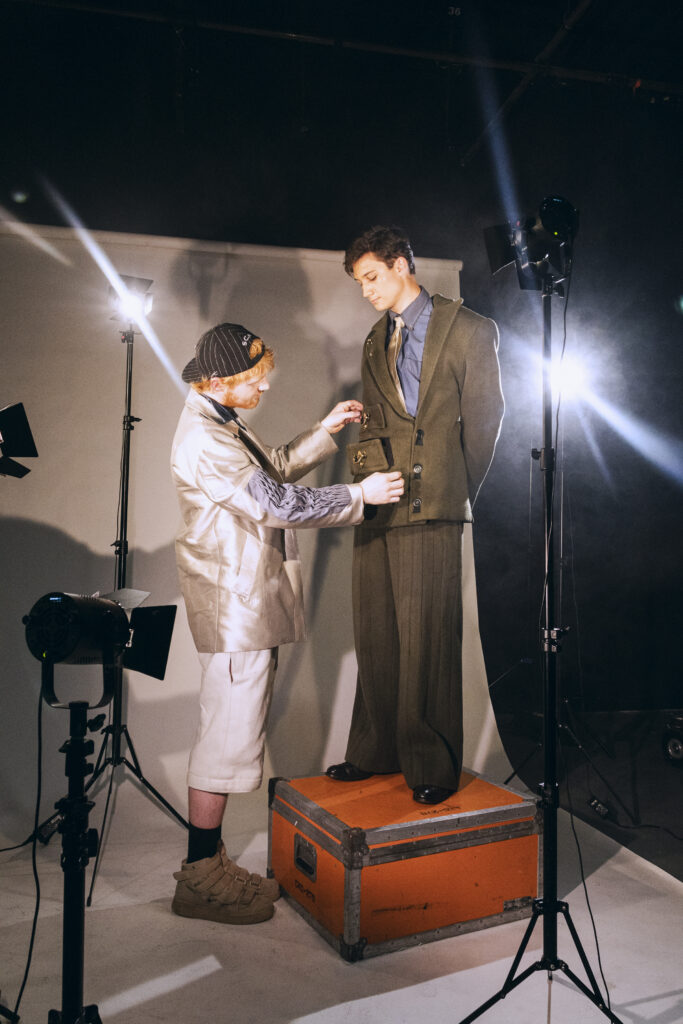
He shares his strong conceptual statement in a more simplified manner: “It follows the story of the FBI agent Fox Mulder, as he starts to uncover conspiracies about the people that rule the world and governing people and control, the general population.” Upholding his appreciation for the skeptic character that is Mulder, Stoddard also mainly works alone. He tells me each garment took about two weeks of construction. It’s hard to choose a favorite when each area has been crafted so purposefully, one jacket featuring drawers (yes, drawers) that are actually functional in the sense of opening! However, his favorite (and objectively mine) is a trench coat with a built-in corset channeled into the back through a belt. “I actually dyed all of the fabric myself. So everything you see on the rack started out as white.” Noting that a friend of his, who’s also a fashion design major, Jake Jurchak, “did all of the leather hardware for my collection, all of the belts and straps. Everything else I did fully by myself.”
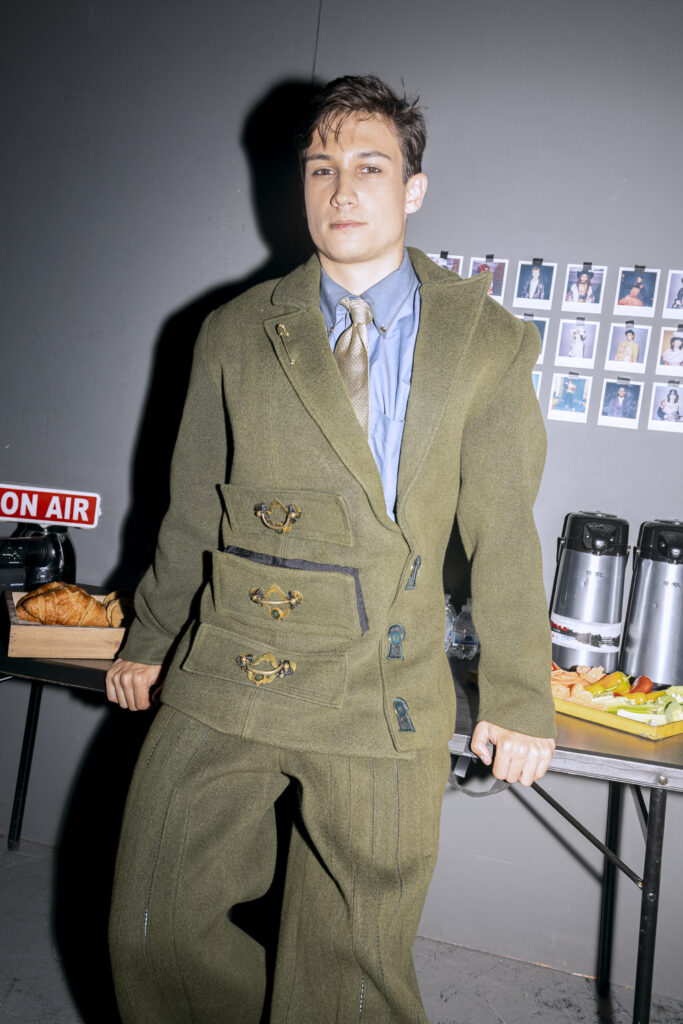
The current state of government reflects a profound need for people with an investigative nature, such as Stoddard. “I always had a very inquisitive brain about higher powers and people telling us what to do. I’ve always had a problem with government and control, so I really wanted to have my collection reflect my surrealist, artistic qualities but also speak to a more important issue on who’s controlling us. And why do we listen to what the government says?” Each look reflects this interest incredibly well as he starts to drift into a world of surrealism, where he starts to lose touch with reality. “Who’s actually in control? Where? Why does the government want us to do certain things?” Stoddard’s collection is impressively made and encapsulates a passionate artist feening to uncover the world of governance through an ode to surrealist fashion.
Flor Renata Sanchez Mahwah, NJ
Mexican American fashion designer Flor Renata Sanchez dives deep into her experience growing up in the United States through “Flores Del Mal”, which translates to Flowers of Evil while touching on the much broader issue of cultural fetishization. “It really starts with the idea of the fetish, and my experiences as a Mexican American growing up here in the States, and my experience being fetishized, being seen as body rather than mind…I grew up in a very white town, and that’s what my concept dives into a bit. I was really being put into that box of fetish rather than a mind by my peers. And I didn’t face that with my community, in the Mexican community, Latino community. It was always, you know, a fantasy of the other, someone outside of their world. So that really played into part of my collection.”
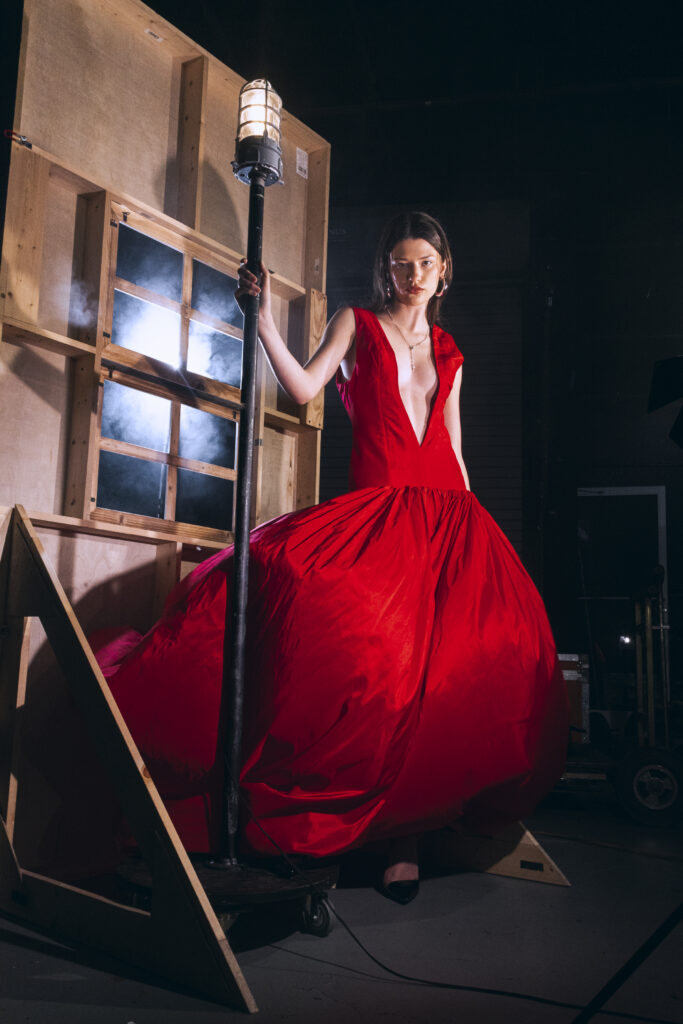
Split up into four parts, Sanchez categorizes her collection into the fetish, the grotesque, the divine, and the resilience. She took inspiration from the women who fought in the Mexican Revolution. One look directly takes from the Zoot Suit, whilst the showstopper, a stunning partly silk taffeta scarlet red floor-length dress with a deep v-cut on front and back, takes from divine laws in faith. “Ultramarine blue is used to depict divinity historically. On the contrary, scarlet red can be used to depict sin. So I was using that contrast.” Unfortunately, I did not get a chance to see her favorite as it was simply too heavy for her to transport, but she describes it well. “I designed a capelet that features the felting detail and is 10 yards of ruffles. It was a pain to sew. It’s a floor length capelet, and under it, a bra and shorts, and when it’s covered up, it’s very regal.”
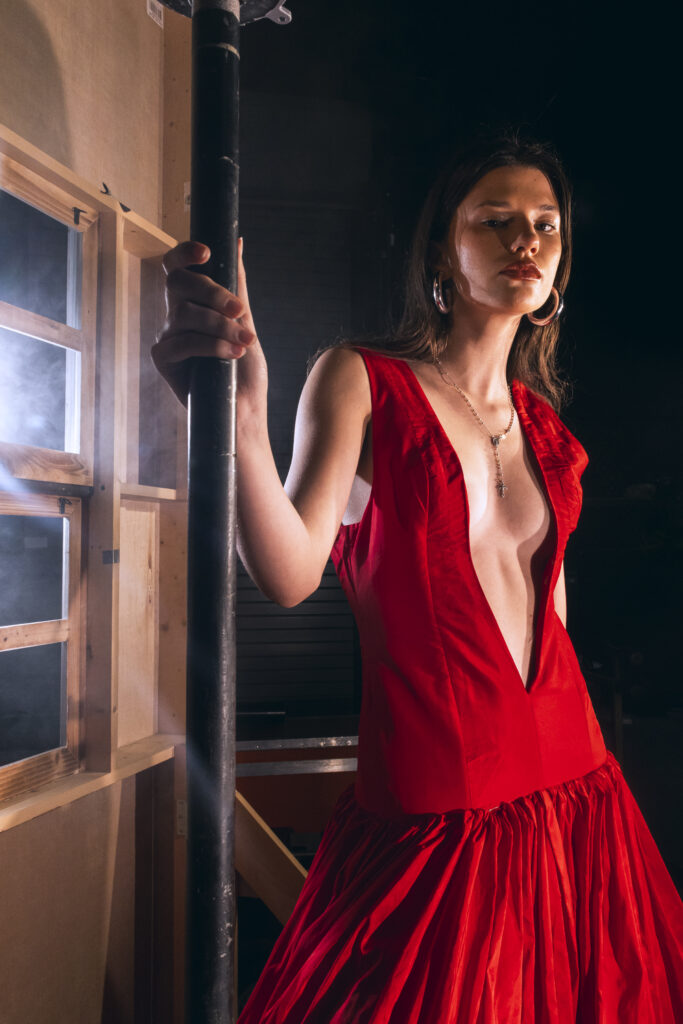
You can tell her experience growing up as a Mexican American elegantly influences her art, but it is also clear she wants to share with and allow others to take away the same sentiments. Sanchez doesn’t reference other designers when creating but rather literature and nods to religion, which allows her to showcase an experience that is rich and complex while clearly making a unique and personal statement.
Allie Jansen Galveston, TX
Through her collection “Flight of The Navigator”, designer Allie Jansen reclaims the long-lost story of Amelia Earhart, looking into her disappearance and “shifting the narrative to where she never disappears, but she transforms into her machine to survive.”

As we spoke, I could tell these garments are Jansen’s babies. A lot of her materials were sourced from the UK, making it feel as though the pieces really are one with the skies after having to navigate their way to her in Savannah. Selflessly, she tells me it is not just her collection but rather the result of a large team that has come together.
Jansen showed me specific elements of her collection, and I couldn’t help but brush my hands over the Swarovski crystals. She explained that adding certain details that are considered “feminine” (the crystals, the trompe l’oeil print, etc.) was an important part of the process. “Flight of The Navigator” is not womenswear or menswear but “just wear.” The fluidity of the collection disrupts the traditional industry narrative on a multitude of levels; Jansen designs for the modern person that doesn’t fit into one place in society and rather has to create the space for themself. “I think Amelia was someone too that pushed that boundary of the masculine and feminine, and I feel that in my personal self, as well as, just kind of the ethos of what is happening in today’s society. I don’t believe in gendered clothing.”
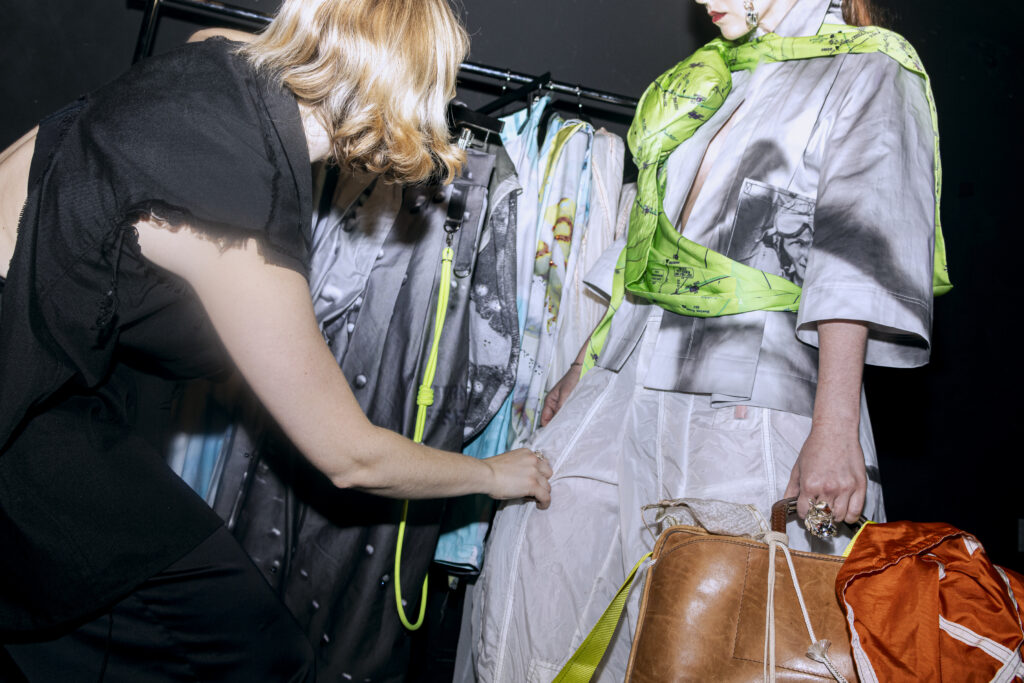
Being scared of the sky is one of the most common fears in society, but don’t let that stop you from boarding the flight that is “Flight of The Navigator”. Debuting her collection through film, captured at none other than Savannah Aviation, she tells me, “we really wanted to do right by the aviation community area.” Jansen tells a larger story within itself that I find to be incredibly interesting. One that all comes back to Amelia Earhart, “guardian of the skies with her navigator.”
Creative Direction, Curated, & Produced by Evan Skovronsky
Photography by Cameron Emory
Fashion Curation & Styling by Anna Jara
Production Design by Iyerlie Feist
Interviews by Miia Popovics, Elisabeth Edwards, & Ben Pulka
Photography Assist by Paige Albert
Makeup by Ari Young Sang
Assisted by Eve Friday, Aubrey Lauer, & Mishi Ali
Video by Kaden K. Jones
Talent by Ivan Kuo, Ben Pulka, Chloay Jean-Miles, Trey Alexander, Jade Imani, Kyle Anderson, Sadie Bartletta, Lance Featherstone, Sydney Geiger, & Stephanie Hayes

